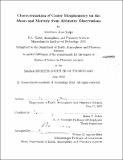Characterization of crater morphometry on the Moon and Mercury from altimetry observations
Author(s)
Talpe, Matthieu Jean
DownloadFull printable version (4.944Mb)
Other Contributors
Massachusetts Institute of Technology. Dept. of Earth, Atmospheric, and Planetary Sciences.
Advisor
Maria T. Zuber.
Terms of use
Metadata
Show full item recordAbstract
Recently acquired altimetry data from laser altimeters are used to assess the morphometry of impact craters. Data acquired by the Mercury Laser Altimeter on the MESSENGER spacecraft are used to measure the depths and diameters of 537 craters at the high northern latitudes on Mercury, including 42 polar-deposit-hosting craters (PDCs) which host material that is bright to earth-based radar observations. A comparative analysis suggests that the radar-bright material forms a thin (< 20 m) layer emplaced preferentially in comparatively young craters, contradicting an earlier morphometric study that indicated that PDCs contained a thick layer of water ice and dust. Topographic datasets from the lunar surface, collected by the Lunar Orbiter Laser Altimeter onboard the LRO spacecraft, are also used to evaluate the morphometry of 1,356 lunar craters. We study the morphologic change between the simple and complex crater regime, a manifestation of the transition between gravity-dominated and strength-dominated impact-forming processes, on the Moon and Mercury. The Moons transition diameter is near 16 km, in line with previous studies, while Mercurys is near 8 km, 2 km smaller than previously determined. The onset of gravity-dominated mechanisms scales inversely with gravity, which explains why Mercurys transition diameter is approximately half of the Moons.
Description
Thesis (S.M.)--Massachusetts Institute of Technology, Dept. of Earth, Atmospheric, and Planetary Sciences, 2012. Cataloged from PDF version of thesis. Includes bibliographical references (p. 51-55).
Date issued
2012Department
Massachusetts Institute of Technology. Department of Earth, Atmospheric, and Planetary SciencesPublisher
Massachusetts Institute of Technology
Keywords
Earth, Atmospheric, and Planetary Sciences.